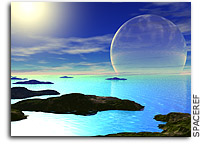Endurance of Plants Under Quartz Rocks Possible Model for Life on Early Earth

DURHAM, N.C. — Microscopic Mojave Desert plants growing on the underside of
translucent quartz pebbles can endure both chilly and near-boiling temperatures,
scavenge nitrogen from the air, and utilize the equivalent of nighttime
moonlight levels for photosynthesis, a new study reports. The plants, which
receive enough light through the pebbles to support photosynthesis, could offer
a model for how plants first colonized land, as well as how they might have
evolved on Mars, said the scientists who performed the study.
"Here you have a really bizarre habitat," said William Schlesinger, dean of Duke
University’s Nicholas School of the Environment and principal author of a paper
on the study that appears in the December, 2003 issue of the research journal
Ecology, which was just published. "When I first went to the site in 1978 I
thought: ‘That’s weird, how do these plants photosynthesize?’ Then it dawned on
me that they photosynthesized on the light coming through the rocks."
Years after he first noticed the primitive plants — mostly species of
blue-green algae — growing under every quartz pebble he turned over at the site
in California’s Joshua Tree National Park, Schlesinger assembled a scientific
team to investigate the phenomenon. He said what the scientists learned suggests
a possible way that land plants established their first toehold in the harsh
conditions of the early Earth: by staying under cover.
Such habitats may also be "prime locations to search for extraterrestrial life"
on other planets, wrote Schlesinger and his other team members in their paper.
Other authors include Schlesinger’s technician Jeffrey Pippen and Duke graduate
students Matthew Wallenstein and Kirsten Hofmockel; also Bruce Mahall of the
University of California at Santa Barbara and Debra Klepeis, Mahall’s graduate
student.
Under Schlesinger’s direction, Pippen counted 295 whitish, light transmitting
quartz pebbles commingled with a much larger number of opaque black pebbles
within a 1-by-50 meter desert test plot. The scientists found all quartz pebbles
that were about one inch or less thick supported active plant colonies on their
undersides. Quartz pebbles thicker than one inch still had rings of plant life
around those parts of their bottom edges where sunlight could penetrate through
the stone at an oblique angle.
By placing heat sensors above and below some of the pebbles in all four seasons,
the scientists documented that living under the quartz pebbles kept the plants
warmer in winter and cooler in summer compared to conditions underneath black
pebbles. In fact, their Ecology paper suggested that sunlight transmitted
through the translucent quartz might "confer a modest greenhouse effect" during
the cooler months, in essence trapping some of the sun’s heat.
Comparatively moderate though they were, temperatures underneath the quartz
pebbles still logged as low at 41 degrees Fahrenheit in January and almost 150
degrees Fahrenheit at midday in August under harsh desert conditions.
The researchers then brought some pebble samples back to their laboratory at
Duke and heated them to 194 degrees for six hours. Despite that ordeal in the
lab, when the baked rocks were then moistened, their resident plant colonies
proved still able to photosynthesize. Photosynthesis is the process by which
plants synthesize sugars using atmospheric carbon dioxide through the action of
light on green chlorophyll molecules.
The algae’s demonstration of high temperature resilience presented a paradox,
because chlorophyll molecules themselves normally begin to degrade at about 167
degrees, according to Schlesinger, who is a biogeochemist and ecologist. "Either
they have some special kind of chlorophyll, or they were in a resting phase
which bacterial groups can go into to get through really extreme conditions,"
Schlesinger said. Blue-green algae are more properly called cyanobacteria.
Wallenstein’s DNA identification of the algae species in plant colony samples
revealed 26 different kinds of cyanobacteria. Of those, the Ecology paper
suggested that five species may be previously unknown to science.
Cyanobacteria are suspected of being "one of the first colonizers of land" on
Earth, Schlesinger noted — a time when there was no atmospheric ozone shield to
block harmful solar ultraviolet radiation and no nitrogen-rich topsoil covering
the ground. The lack of soil nitrogen provided no obstacle for the plant
colonies living under the quartz rocks. Hofmockel, another of Schlesinger’s
graduate students, found those algae obtain the nitrogen they needed for growth
directly from the air like some less primitive plants are also able to do.
The UC Santa Barbara researchers found that the pebbles did not filter out more
ultraviolet rays than they did other wavelengths of sunlight, meaning that
quartz did not provide an especially protective environment. On the other hand,
analysis also showed that that only about .08 percent of the light of any
wavelength that entered one-inch-thick pebbles could reach plants on the other
end. "That’s pretty shady," Schlesinger added. "That’s like photosythesizing by
moonlight on the bottom of the thickest rocks."
"The growth of hypolithic (beneath rocks) algae under diaphanous quartz pebbles
in the Mojave Desert is another illustration of the successful microbial
exploitation of a novel habitat in an otherwise harsh environment," the authors
concluded in their Ecology paper. "Similar environments might harbor life on
other planets," the paper added.
While the paper did not specify which other planets, Schlesinger singled out
Mars, whose surface is known to harbor quartz rock, be extremely dry and cold,
and receive larger doses of ultraviolet radiation than Earth’s surface does
today. "Right now Mars doesn’t look too good for life," Schlesinger said. "But
if Mars had something alive two billion years ago, when it is believed to have
been slightly wetter, this might have been where that something lived."









